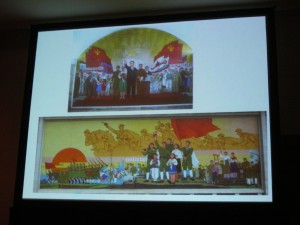Compiled by Dr. Paul D. Barclay, Professor of History, Lafayette College
Data and Reports
Science. Articles about COVID-19 are unlocked. https://science.sciencemag.org/
The Lancet (open access): https://www.thelancet.com/coronavirus
Nextstrain (Real-time tracking of pathogen evolution) https://nextstrain.org/ (Thanks Professor James Orr)
“Coronavirus COVID-19: Global Cases by the Center for Systems Science and Engineering (CSSE) at Johns Hopkins University (JHU).” Accessed March 27, 2020. https://coronavirus.jhu.edu/map.html
Wu, Jin, Weiyi Cai, Derek Watkins, and James Glanz. “How the Virus Got Out.” New York Times, March 22. Accessed March 27, 2020. https://www.nytimes.com/interactive/2020/03/22/world/coronavirus-spread.html
Wu, Jin, Allison McCann, Keith Collins, Karen Yourish, et. al. “Coronavirus Map: Tracking the Global Outbreak.” New York Times, last updated March 27. Accessed March 27, 2020. https://www.nytimes.com/interactive/2020/world/coronavirus-maps.html
Desjardins, Jeff. “The 7 Best COVID-19 Resources We’ve Discovered So Far.” Visual Capitalist, March 24. Accessed March 27, 2020. https://www.visualcapitalist.com/7-best-covid-19-resources/
World Health Organization Situation Reports
https://www.who.int/emergencies/diseases/novel-coronavirus-2019/situation-reports/
Debunking Myths about COVID-19
Snopes.com fact-checking website. https://www.snopes.com/
Historical Context
A collection of open access articles: “Anthropology and Epidemics, a Quarantine Reading List.” American Ethnologist. April 21, accessed April 23, 2020. https://anthrosource.onlinelibrary.wiley.com/doi/toc/10.1111/(ISSN)1548-1425.anthropology-and-epidemics?fbclid=IwAR1DuS5_kCPJiC01m-jtLLZ6n9b-cFRwj_VvYbZg0KgZFHPZy80WwXGlAyg
Strochlic, Nina and Riley D. Champine. “How Some Cities ‘Flattened the Curve’ During the 1918 Flu Pandemic. National Geographic. March 27, accessed April 20, 2020. https://www.nationalgeographic.com/history/2020/03/how-cities-flattened-curve-1918-spanish-flu-pandemic-coronavirus/?fbclid=IwAR3F2BPobXBcTQv-aOwsbl30f13PebmfYEG1WLuij3aVm9R-1Yic1QxWDFY/
Kolbert, Elizabeth. “Pandemics and the Shape of Human History.” The New Yorker. April 6, Accessed April 9, 2020. https://www.newyorker.com/magazine/2020/04/06/pandemics-and-the-shape-of-human-history.
Rhodes, Ben. “The 9/11 Era Is Over.” The Atlantic. April 6, Accessed April 11, 2020. https://www.theatlantic.com/ideas/archive/2020/04/its-not-september-12-anymore/609502/ (Thanks Professor Josh Sanborn)
De Waal, Alex. “New Pathogen, Old Politics: Thinking in a Pandemic.” Boston Review, April 3. Accessed April 11, 2020. http://bostonreview.net/science-nature/alex-de-waal-new-pathogen-old-politics (Thanks Professor Jeremy Zallen).
Porter, Katherine Anne. Pale Rider, Pale Horse: Three Short Novels. (published in 1939).https://en.wikipedia.org/wiki/Pale_Horse,_Pale_Rider
- New York Review of Books excerpt from Pale Rider, Pale Horse: https://www.nybooks.com/daily/2020/03/21/pale-horse-pale-rider-a-story-of-the-1918-flu-pandemic/ (Thanks Professor Michael Clark).
Timelines
“Maps and Trends: Hubei Timeline.” Center for Systems Science and Engineering (CSSE) at Johns Hopkins University (JHU). Accessed April 28, 2020. https://coronavirus.jhu.edu/data/hubei-timeline
“Daily Confirmed New Cases (5-day moving average).” Center for Systems Science and Engineering (CSSE) at Johns Hopkins University (JHU). Accessed April 28, 2020. https://coronavirus.jhu.edu/data/new-cases
Schumaker, Erin. “Timeline: How Coronavirus Got Started.” ABC News, March 25. Accessed March 27, 2020. https://abcnews.go.com/Health/timeline-coronavirus-started/story?id=69435165
“Coronavirus Outbreak Timeline Fast Facts.” CNN, March 26. Accessed March 27, 2020. https://www.cnn.com/2020/02/06/health/wuhan-coronavirus-timeline-fast-facts/index.html
“Timeline: How the New Coronavirus Spread.” Al Jazeera, March 27. Accessed March 27, 2020. https://www.aljazeera.com/news/2020/01/timeline-china-coronavirus-spread-200126061554884.html
Taylor, Derrick Bryson. “A Timeline of the Coronavirus Pandemic.” New York Times, March 27. Accessed March 27, 2020. https://www.nytimes.com/article/coronavirus-timeline.html
Allen-Ebrahimian, Bethany. “Timeline: The Early Days of China’s Coronavirus Outbreak and Cover-Up.” Axios, March 18. Accessed March 27, 2020. https://www.axios.com/timeline-the-early-days-of-chinas-coronavirus-outbreak-and-cover-up-ee65211a-afb6-4641-97b8-353718a5faab.html
Kiernanand, Samantha and Jason Socrates Bardi. “UPDATED: Timeline of the Coronavirus.” Think Global Health (Council on Foreign Relations), March 3. Accessed March 27, 2020. https://www.thinkglobalhealth.org/article/updated-timeline-coronavirus
Chalfant, Morgan and Brett Samuels. “White House Grapples with the Coronavirus Outbreak: A Timeline.” The Hill, March 23. Accessed March 23, 2020. https://thehill.com/homenews/news/488942-white-house-grapples-with-the-coronavirus-outbreak-a-timeline
Geraghty, Jim. “The Comprehensive Timeline of China’s COVID-19 Lies.” National Review (blog), March 23. Accessed March 29, 2020. https://www.nationalreview.com/the-morning-jolt/chinas-devastating-lies/
Journalism/Opinion
Atlantic Monthly (open access): https://www.theatlantic.com/category/what-you-need-know-coronavirus/
New York Times (open access): https://www.nytimes.com/news-event/coronavirus
Foreign Affairs (open access): https://www.foreignaffairs.com/tags/coronavirus
PBS. https://www.pbs.org/articles/2020/02/heres-what-you-should-know-about-the-novel-coronavirus/
BBC News. https://www.bbc.com/news/coronavirus
Caixin Global 财新传媒 https://www.caixinglobal.com/2020/coronavirus-live-update/
Think Global Health (an initiative of the CFR): https://www.thinkglobalhealth.org/
The Nation https://www.thenation.com/keyword/coronavirus/
The National Review https://www.nationalreview.com/
The Economist (pay wall): https://www.economist.com/news/2020/03/11/the-economists-coverage-of-the-coronavirus
Wall Street Journal (pay wall): https://www.wsj.com/livecoverage/coronavirus
Higher Education and COVID-19
Maloney, Edward J. and Joshua Kim. “15 Fall Scenarios: Higher Education in a Time of Social Distancing. Insider Higher Ed. April 22, accessed April 27, 2020. https://www.insidehighered.com/digital-learning/blogs/learning-innovation/15-fall-scenarios#
Paxson, Christina. “College Campuses Must Reopen in the Fall. Here’s How We Do It.” New York Times. April 26, accessed April 27, 2020. https://www.nytimes.com/2020/04/26/opinion/coronavirus-colleges-universities.html
Wood, Graeme. “There’s No Simple Way to Reopen Universities.” The Atlantic. April 27, accessed April 27, 2020. https://www.theatlantic.com/ideas/archive/2020/04/colleges-are-weighing-costs-reopening-fall/610759/
Inspiration from World Leaders
Angela Merkel:
- Davidson, Justin. “The Leader of the Free World Gives a Speech, and She Nails It.” New York Magazine. March 18, accessed April 27, 2020. https://nymag.com/intelligencer/2020/03/angela-merkel-nails-coronavirus-speech-unlike-trump.html?fbclid=IwAR26x5amARiGYbyBI5wfIU2AlawIbOg8j6mSXpiWhHJv-TuRW5FFwxaGGHA
Queen Elizabeth II:
- Landler, Mark. “Boris Johnson Hospitalized as Queen Urges British Resolve in Face of Epidemic.” New York Times. April 5, accessed April 27, 2020. https://www.nytimes.com/2020/04/05/world/europe/coronavirus-queen-elizabeth-speech.html?searchResultPosition=1

























